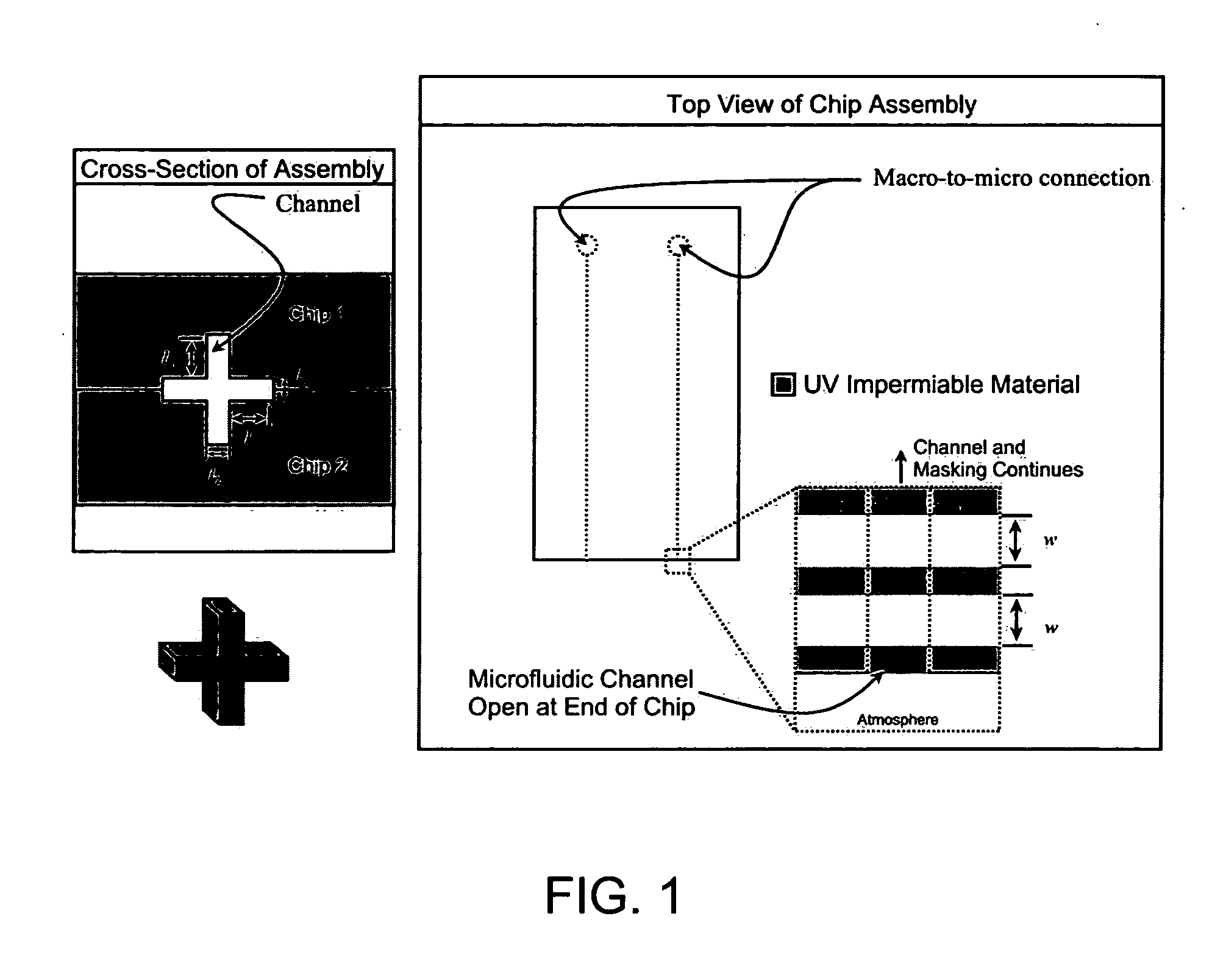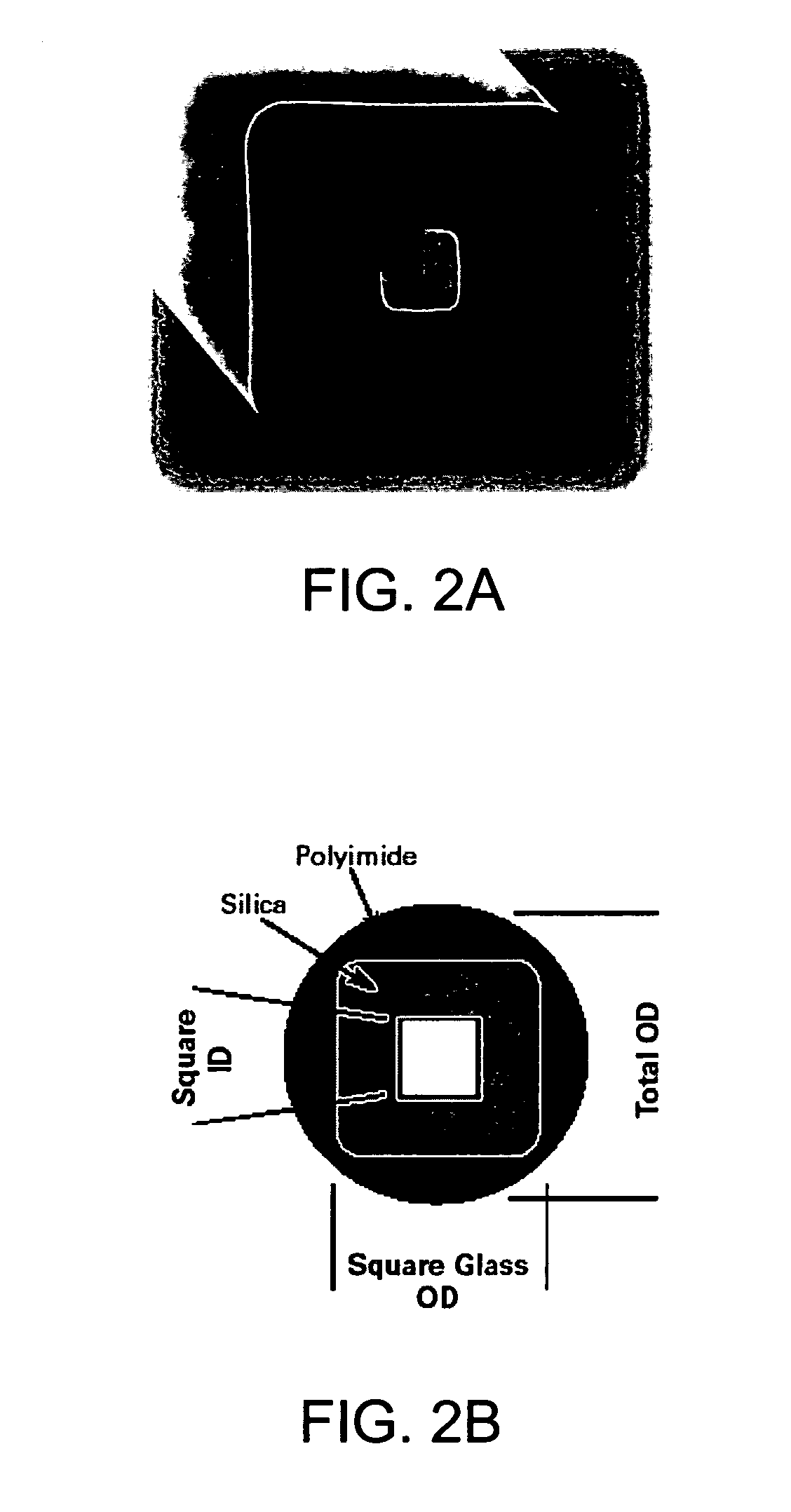Polymeric microstructures
a microstructure and polymer technology, applied in the field of polymer science and microstructure technology, can solve the problems of ineffective cell culture applications, limited surface texture and composition of conventional spherical micro-porous beads made by immiscible liquid-liquid polymerization method, and insufficient cell culture efficiency, etc., to achieve optimal substrate curvature, improve the efficiency of bioreactor-based cell culture systems, and improve the effect of surface area to volume ratio
- Summary
- Abstract
- Description
- Claims
- Application Information
AI Technical Summary
Benefits of technology
Problems solved by technology
Method used
Image
Examples
example 1
Synthesis of Fibers
[0054] The fibers shown in FIG. 4 were made in a four-fold axial symmetric capillary (square cross-section as seen in FIG. 2) using a poly(Trimethylolpropane Triacrylate-co-ethylene dimethacrylate) System. The prepolymer solution was flowed into the UV-exposed region of a capillary at a low, constant flow rate. The pre-polymer system used in this synthesis was a PIPS solution so, at a point determined by the thermodynamics of the system, there was a nucleation and growth phase separation that occurred. This phase-separation created the porous structured fibers seen in FIG. 4. This synthesis can also be accomplished in the same manner using a microfluidic chip. The fiber seen in the image can be seen to be composed of partially coalesced nano-particles. The surfaces of these fibers show a roughly uniform level of surface roughness and a high level of porosity. The protocol listed below was conducted 25° C. and 1 atm. The polymer flow was induced using a low-flow r...
example 2
Another Example of a Prepolymer System
[0062] Another prepolyer system that can be utilized in the same manner as in Example 1 is composed of 0.96 g of Ethylene Glycol Dimethacrylate (EGDMA, δD=17.2 J1 / 2 cm−3 / 2, δP=0.2 J1 / 2cm−3 / 2, δH=8.8 J1 / 2cm−3 / 2, δ=19.3 J1 / 2cm−3 / 2), 1.301 g of Hydroxyethylmethacrylate (HEMA, δD=17.8 J1 / 2cm−3 / 2, δP=0.4 J1 / 2cm−3 / 2, δH=14.8 J1 / 2cm−3 / 2, δ=23.2 J1 / 2cm−3 / 2), 24 mg of AIBN, and 3.6 g of a porogenic solvent in a UV-initiated polymerization reaction. The solvent system used is Methanol (MeOH, δD=15.2 J1 / 2cm−3 / 2, δP=12.3 J1 / 2cm−3 / 2, δH=22.3 J1 / 2cm−3 / 2, δ=29.2-29.7 J1 / 2cm−3 / 2) and Hexane (δD=14.8 J1 / 2cm−3 / 2, δP=0 J1 / 2cm−3 / 2, δH=0 J1 / 2cm−3 / 2, δ=14.8-14.9 J1 / 2cm−3 / 2). In the pure methanol solvent system the median pore size is 54 nm, in the MeOH / EtOH (50 / 50) system the median pore size is 51 nm, and in the MeOH / Hexane (50 / 50) system the median pore size is 7959 nm. Polymerized EGDMA shifts to a higher solubility parameter δ=22.5 J1 / 2cm−3 / 2 (δD=20 J1 / 2cm−3 / 2, ...
example 3
Steps in a Method of Micromold Operation
[0063] This example embodies one of the three preferred methods of creating microcarriers. Micromolding provides the ability to create thousands of microcarriers in one synthesis cycle. This method of fabrication utilizes two microfabricated fused quartz wafers as molds for UV synthesis of the desired cubical microcarriers. This method includes the following steps:
1) Fabrication (UV lithography, laser processing, etc.) of two replicate surfaces.
2) When the surfaces are glass, the surfaces are treated with a material (e.g., flourosilane) that deactivates the surface, so the polymer does not adhere to the surface of the mold.
3) The molds are filled with the prepolymer solution
a. With Interconnecting Channels
b. The chips are aligned and the assembly is closed
i. The prepolymer solution is degassed prior to injection into the assembly
ii. The assembly is then filled with a prepolymer from a central port
iii. Without Interconnecting C...
PUM
| Property | Measurement | Unit |
|---|---|---|
| size | aaaaa | aaaaa |
| size | aaaaa | aaaaa |
| molecular weight | aaaaa | aaaaa |
Abstract
Description
Claims
Application Information
 Login to View More
Login to View More - R&D
- Intellectual Property
- Life Sciences
- Materials
- Tech Scout
- Unparalleled Data Quality
- Higher Quality Content
- 60% Fewer Hallucinations
Browse by: Latest US Patents, China's latest patents, Technical Efficacy Thesaurus, Application Domain, Technology Topic, Popular Technical Reports.
© 2025 PatSnap. All rights reserved.Legal|Privacy policy|Modern Slavery Act Transparency Statement|Sitemap|About US| Contact US: help@patsnap.com



